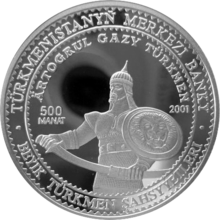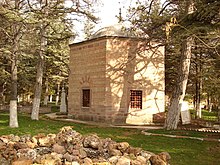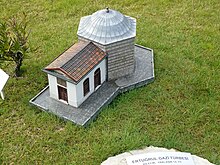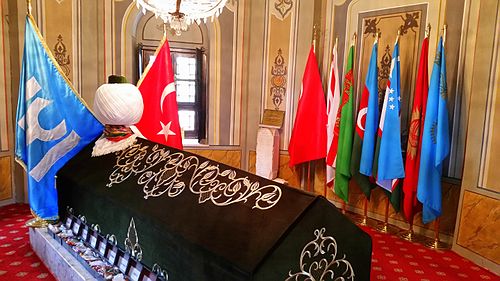Ertuğrul Gazi

Ertuğrul Gazi ( Ottoman أرطغرل Erṭoġrıl , İA Erṭuġrul ; Turkish for he 'male' and tuğrul 'a bird of prey'; born in 1198 in Ahlat ; died 1281 or 1282 in Söğüt ) was an Oghusian clan leader and the father of Osman I , who founded the Ottoman dynasty and gave the Ottoman Empire its name.
swell
Contemporary Islamic or Byzantine sources about Ertuğrul do not exist. The contemporary source Pachymeres and the later sources Kantakuzenos or Ibn Battuta do not mention Ertuğrul. It was considered certain that the earliest mention was made at the end of the 14th century in a letter from Bayezid I to Tamerlane . But older sources were discovered. On the one hand, there is a coin from Osman's time (died 1324) on which both Ertuğrul and his father Gündüz Alp are recorded. On the other hand, there is a reference to Ertuğrul in a cadastral booklet about a donated estate in Söğüt (ارطغرل جانى ايچون Ertuğrul canı içün , German 'For the soul of Ertuğrul' ). This land register entry is considered the earliest mention of Ertuğrul today.
Detailed information about Ertuğrul can be found in the first chronicles of the Ottoman dynasty . These date from the 15th century. The first chronicles sound largely legendary.
Life
Ertuğrul was the leader of a Turkmen ( Oghuz ) clan who migrated to Asia Minor in the course of Mongol raids and probably arrived there in the years 1234–1235. In Anatolia , Ertuğrul settled in Söğüt (near Kütahya in the Bilecik province ). There, Ertuğrul was the ruler of one of the border principalities of the Seljuq sultans in Iconium, later Konya . He took part in the wars of his Seljuk overlord against the Mongols and undertook raids on Byzantine territory.
family tree
The first Ottoman chronicles state that Osman Gazi's father was Ertuğrul and belonged to the Oghuz sub-tribe Kayı . The sources lead Ertuğrul's family tree back to Oğuzhan and from there to the prophet in Islam Noah . The first Ottoman historians Ahmedî , Enverî , Karamânî Mehmed Pascha state that Ertuğrul's father was Gündüz Alp . Other sources such as Aschikpaschazade say that his father was Suleyman Shah . This is considered to be incorrect. Today it is certain that Gündüz Alp was Ertuğrul's father. This is also borne out by a coin from Osman Gazi on theعثمان بن ارطغرل بن كوندوز آلپ Osman bin Ertuğrul bin Gündüz Alp , German 'Osman son of Ertuğrul son of Gündüz Alp' is listed.
The Kayı under Ertuğrul's ancestors
According to tradition, the ancestors of Ertuğrul came to Ahlat during the first conquest of Anatolia under the Seljuq sultans Tuğrul and Alp Arslan and took part in the Gaza wars against Anatolia. Later, accompanied by the Ahlat princes , they waged war against Georgia and the Trapezunt Empire . At the beginning of the 13th century, Ahlat came under Ayyubid rule. With the Mongolian expansion to the west, Ertuğrul's ancestors left Ahlat and moved to Mardin . Here they allied themselves with the sons of Artuks , who also belonged to the Turkmen Kayı. When the Mongols began to plunder Mardin as well, Gündüz Alp and his Turkmen tribe moved on to Pasinler in Inner Anatolia . Gündüz Alp died in Pasinler, Ertuğrul became the new head of the Kayı. During the Mongolian expansion, the Germiyan moved from Malatya to Kütahya.
Affection with the Seljuk house
Tradition continues that Ertuğrul's brothers Sungur Tekin and Gündoğdu returned to Ahlat when the Mongol attacks were also felt in Pasinler, but Ertuğrul moved further west with his other brother Dündar Bey. Near Sivas they are said to have encountered a battle of the Seljuks against Mongols, in which they supported the Seljuks, who then won the battle. This battle is only mentioned in the Cihânnümâ of Neşrî . Historians believe that this can also mean the Yassıçimen battle between Alâeddin Keykubad I and the Khorezm Shahs of 1230. In 1230 Sultan Alâeddin Keykubad gave Ertuğrul as a thank you to Karacadağ near Ankara , where he was to live with his tribe.
After some time in Karacadağ, Ertuğrul sent his son Savcı Bey to the Sultan Alâeddin Keykubad in order to be allowed to colonize a new area. According to the Ottoman sources, Ertuğrul got this permission, after which he and his tribe settled in the vicinity of Söğüt, in the Sakarya Basin .
Now the Kayı were on the borders with Byzantium. From here they raided Byzantine villages and towns. In 1231, Sultan Alâeddin Keykubad started a military operation against Byzantium to secure the western borders of his empire. Ertuğrul Bey and his followers also joined the Seljuk army from Konya in support of the sultan in Eskişehir . The battle in Ermeniderbendi (today: Pazaryeri ) against the troops of the Byzantine emperor Laskaris won the Seljuks with the support of the warriors of Ertuğrul. Alâeddin Keykubad presented Eskişehir as an award to Ertuğrul.
After this victory, Alâeddin Keykubad besieged Karacahisar . When the Mongols ( Ilkhan dynasty in Persia) besieged Anatolia at the time , the Sultan returned to Konya and left Ertuğrul Gazi in charge of the operation. After long fighting, Ertuğrul and the other Turkish princes conquered Karacahisar in 1231/32. They shared the booty among themselves and sent a fifth of the booty and the Tekfur (Christian lords of the castle) to the Sultan. Subsequently, Ertuğrul conquered Söğüt - the capital of the later principality of Osman . The Sultan officially recognized Söğüt as the property of Ertuğrul. Ertuğrul not only waged war against Byzantine princes. He had a friendly relationship with the princes of Belocome (Bilecik) and Melangeia ( Osmaneli ). Söğüt was a kischlak (winter residence) for the Kayı . Domaniç was her yaylak (summer pasture).
Over time, Ertuğrul joined other experienced Uc-Beys such as Samsa Çavuş , Aykut Alp , Akçakoca , Kara Tegin , Konur Alp . As a result, the Oghuz Kayı tribe became more and more powerful.
Late history
Ertuğrul remained a Uc-Bey / border area prince in the service of the Seljuk Sultan. According to tradition, he expressed his loyalty to the Sultan Gıyaseddin Keyhüsrev III in 1279 . and gave him plenty of presents when he visited the western border with Byzantium in 1279. After this date, the aged Ertuğrul handed over the management of the Kayı- Aşirets to his son Osman . He died a few years later (1281 or 1282) at the age of 90. Other sources also give his date of death as 1288/1289. A Türbe outside Söğüt is ascribed to him. There is no early inscription on it. An inscription dates from 1886–1887 for the purpose of restoration.
Film adaptations
- Kuruluş / Osmancık (The Foundation / Osmancık), feature film, Turkey 1987, a TRT production, screenplay: Tarık Buğra, with Baykal Saran as Ertuğrul Gazi
- Diriliş: Ertuğrul (Ertuğrul's Resurrection), TV series, Turkey 2014, a TRT production, production: Tekden-Film / Mehmet Bozdağ, director: Metin Günay, with Engin Altan Düzyatan as Ertuğrul
literature
- VL Ménage: Article Ertoghrul. In: Encyclopaedia of Islam.
- JH Mordtmann: Article: Ertoghrul. In: EJ Brill's First Encyclopaedia of Islam 1913-1936 , Leiden 1987, Volume III
- Hans Miksch: The struggle of the emperors and caliphs. Bonn 1986
Individual evidence
- ↑ a b c V. L. Ménage: Article Ertoghrul. In: Encyclopaedia of Islam.
- ↑ a b c d e f g h i j k l m Fahamettin Başar: Ertuğrul Gazi. In: Türkiye Diyanet Vakfı İslâm Ansiklopedisi. Vol. 11, Istanbul 1995, p. 314 f. ( PDF file; 1.8 MB ).
- ↑ Halil İnalcık: Osman I. In: Türkiye Diyanet Vakfı İslâm Ansiklopedisi. Vol. 33, Istanbul 2007, pp. 443–453, here: p. 444 ( PDF file; 10.2 MB ).
- ↑ Ömer Lütfi Barkan: Hüdavendigâr Livası Tahrir Defterleri (German: Bursa's land register ), p. 283
- ↑ VL Ménage: Article Ertoghrul. In: Encyclopaedia of Islam. - "largely legendary in tone"
- ↑ JH Mordtmann: Article Ertoghrul. In: EJ Brill's First Encyclopaedia Of Islam 1913-1936. Leiden 1987, Volume III
- ↑ M. Baha Tanman: Ertuğrul Camii ve Türbesi. In: Türkiye Diyanet Vakfı İslâm Ansiklopedisi. Vol. 11, Istanbul 1995, p. 316 f. ( PDF file; 1.6 MB ).
- ↑ "Kuruluş / Osmancık", TV Dizisi 1987 , sinematurk.com
| personal data | |
|---|---|
| SURNAME | Ertuğrul Gazi |
| BRIEF DESCRIPTION | Oghusian clan leader and the father of Osman I. |
| DATE OF BIRTH | 1198 |
| PLACE OF BIRTH | Ahlat |
| DATE OF DEATH | 1281 or 1282 |
| Place of death | Söğüt |


